Isn't it fascinating how a simple dress can tell a story of transformation? In "My Fair Lady," every outfit Eliza Doolittle wears marks a pivotal moment in her journey from the streets of London to high society. Designed by Cecil Beaton, these costumes not only showcase the elegance of the era but also highlight deeper themes of identity and class. As you consider the significance of her wardrobe choices, you might wonder how these outfits influence our perception of her character and the narrative itself.
Overview of My Fair Lady
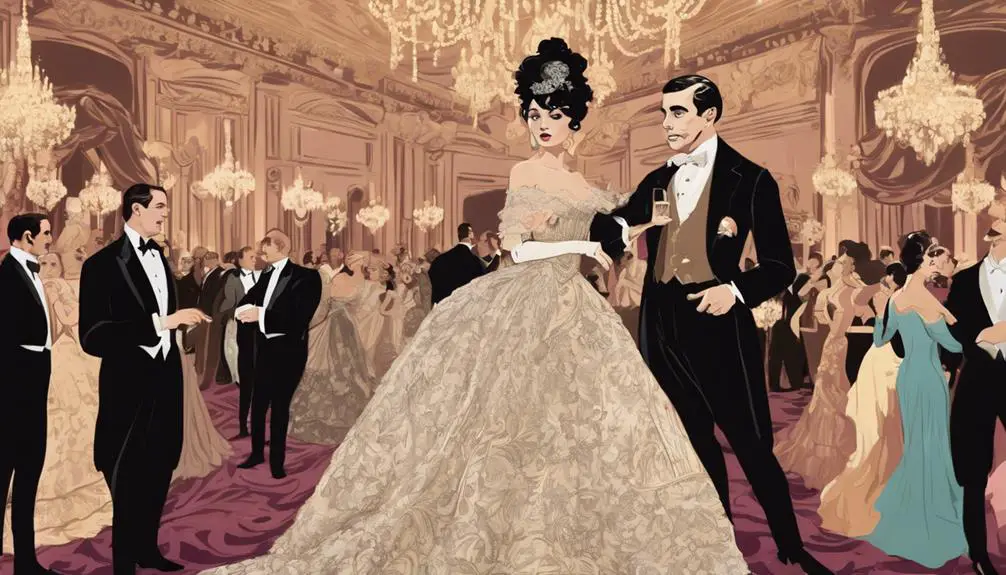
My Fair Lady's charming narrative unfolds in early 20th-century London, where you'll witness the remarkable transformation of Eliza Doolittle, a flower girl with dreams of rising above her station. Played by the enchanting Audrey Hepburn, Eliza's journey from the streets to sophistication is beautifully captured through a stunning array of costumes designed by the talented Cecil Beaton. His work in My Fair Lady showcases approximately 1,500 costumes that not only earned him an Oscar for Best Costume Design but also set a benchmark for visual storytelling in cinema.
Each outfit Eliza wears reflects her character development, starting with her humble, tattered flower girl dress, which symbolizes her working-class roots. As she begins her quest to learn proper speech and manners, her wardrobe evolves dramatically. You can't help but admire her stunning evening gowns and elegant dresses, which highlight the stark contrast between her modest beginnings and her ultimate transformation into a refined lady.
The costumes in My Fair Lady are not just an indication of Edwardian fashion; they also resonate with contemporary styles, influencing designers and fashion enthusiasts for generations. You'll find yourself captivated by how Beaton's designs enhance the narrative, making Eliza's metamorphosis not just a personal journey but a visual spectacle. This film serves as a timeless reminder of the power of fashion in storytelling, showcasing how clothes can symbolize one's aspirations and dreams.
Costume Designer Insights
Exploring the insights of costume designer Cecil Beaton reveals how his artistry shaped the visual narrative of My Fair Lady. With approximately 1,500 costumes designed for the film, Beaton's meticulous attention to detail and historical accuracy earned him an Oscar for Best Costume Design. His work was essential in illustrating Eliza Doolittle's transformation from a humble flower girl to a sophisticated lady, with each outfit symbolizing her social ascent.
Beaton's creative use of vibrant colors and intricate details contrasted beautifully with Audrey Hepburn's iconic white lace attire, enhancing the film's storytelling. The costumes didn't just serve a practical purpose; they became a visual language that communicated themes of identity and class. In the memorable Ascot races scene, over 400 extras donned elaborate costumes inspired by Edwardian styles, showcasing Beaton's innovative approach to costume design.
His collaboration with Hepburn was equally significant, as he adjusted her costumes to reflect her character's development throughout the film. By ensuring that each outfit resonated with Eliza's journey, Beaton created a wardrobe that not only dazzled the audience but also deepened their understanding of the narrative. Each piece was a carefully curated element of the story, allowing viewers to witness Eliza's transformation in a way that was both visually striking and profoundly meaningful. In short, Cecil Beaton's work in My Fair Lady is a demonstration of the power of costume design in cinematic storytelling.
Eliza Doolittle's Wardrobe
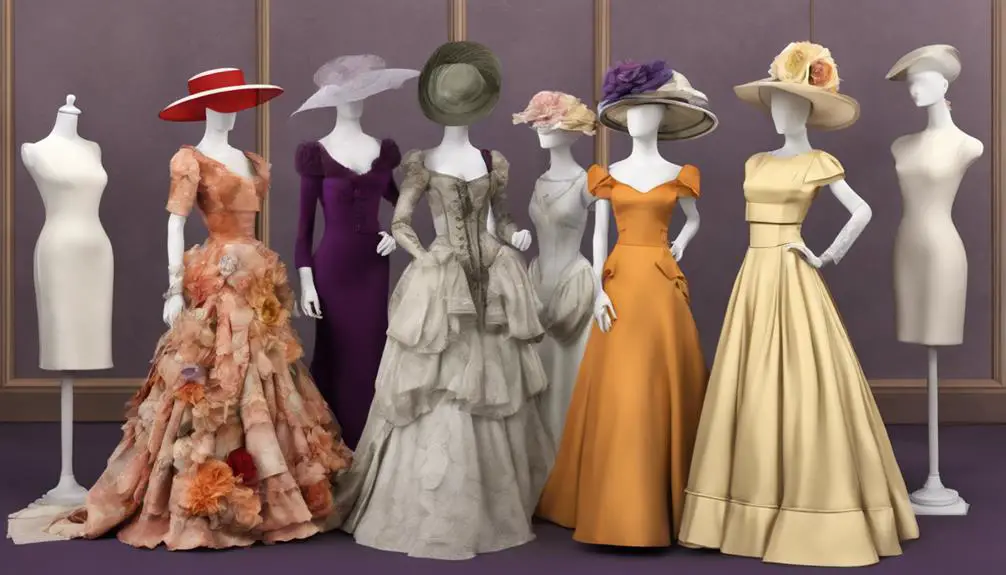
As Eliza Doolittle navigates her transformation from a flower girl to a refined lady, her wardrobe plays a pivotal role in illustrating her journey. The evolution of Eliza Doolittle's outfits, designed by Cecil Beaton, showcases her rags to riches story in stunning detail. From her shabby flower girl dress to elegant evening gowns, each costume symbolizes her aspirations and social ambitions.
In the early scenes, you see Eliza in her worn, dirty dress, a stark contrast to the sophisticated Edwardian style that emerges later. The tan ruffled dress during her speech lessons reflects her desire to improve, while the striking black and white dress worn at the Black Ascot event highlights her increasing elegance and confidence. This outfit not only makes a statement but also serves as a turning point in her journey, emphasizing the film's themes of class and identity.
As she transforms, her evening gowns become more ornate and luxurious, culminating in the jeweled white ball gown that represents her ultimate achievement. Each piece Beaton designed is rich in color and detail, mirroring Eliza's growth and the dramatic shift in her social standing. This wardrobe transformation is not just about clothing; it's a visual narrative of her journey from a humble flower girl to a sophisticated lady, making Eliza Doolittle's wardrobe an integral part of the film's storytelling and charm.
Iconic Outfits in the Film
Throughout "My Fair Lady," you'll find several iconic outfits that not only define Eliza Doolittle's character but also encapsulate the essence of the film's themes. One of the most memorable pieces is the stunning Ascot dress, a dazzling black and white ensemble that perfectly embodies the Edwardian fashions of the time. Worn during the horse race event, it highlights Eliza's initial foray into high society while showcasing the stark contrast between her humble beginnings and newfound aspirations.
As the story progresses, Eliza's wardrobe shifts dramatically, reflecting her growth. The tan ruffled dress she dons during her speech lessons symbolizes her gradual development toward sophistication, demonstrating that change is a journey rather than a destination. By the film's climax, we see her in a breathtaking jeweled white ball gown, adorned with intricate details that signify her ultimate achievement in social aspirations.
Another standout is the pink dress, which, despite debates about its historical accuracy, remains a nostalgic favorite among fans. This dress serves as a visual representation of Eliza's emotional journey, capturing her struggles and triumphs in a world that often feels foreign to her.
These outfits, each with their unique story and significance, contribute to the rich tapestry of "My Fair Lady." They not only enhance your viewing experience but also invite you to reflect on themes of transformation, identity, and the timeless pursuit of self-improvement.
Transformation Through Costumes
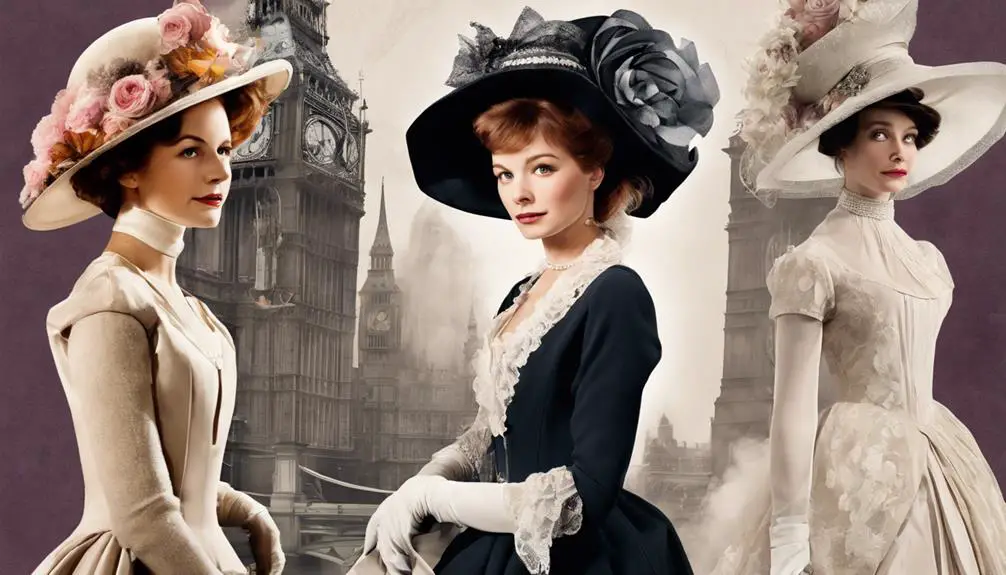
While the costumes in "My Fair Lady" play a pivotal role in conveying Eliza Doolittle's transformation, they also serve as a powerful commentary on societal expectations and identity. You can't help but notice how Eliza's wardrobe evolves dramatically throughout the film, shifting from a shabby flower girl dress to stunning Edwardian evening gowns. This visual representation of her journey from a lower-class flower seller to a refined lady highlights the significant impact of fashion on social class.
Cecil Beaton's designs, which include around 1,500 costumes, are essential in depicting Eliza's transformation. Each outfit she dons marks a milestone in her growth, such as the tan ruffled dress during her speech lessons, symbolizing her budding sophistication. The contrast between her initial attire, filled with dirt and simplicity, and her final ensembles, adorned with jewels and intricate details, powerfully emphasizes themes of social class and identity.
Iconic outfits, like the Ascot dress and jeweled white ball gown, not only showcase Eliza's newfound elegance but also her acceptance into high society. These costumes embody the transformative power of fashion in the early 20th century, illustrating how clothing can redefine one's self-perception and societal standing. As you witness Eliza's metamorphosis, you realize that each costume change is not just about appearance; it's a reflection of her inner journey and the complexities of class and identity in a rapidly changing world.
Cultural Impact of Fashion
The lasting influence of "My Fair Lady" on fashion is undeniable, with Cecil Beaton's iconic designs shaping both film and fashion history. The film's extravagant costumes, particularly seen in the breathtaking Ascot scene, set a new standard for visual storytelling in musicals. With over 400 extras clad in tailored outfits, Beaton's work captured the opulence of the Edwardian Era, creating a visual feast that resonates to this day.
Audrey Hepburn's portrayal of Eliza Doolittle popularized specific fashion elements that continue to inspire modern trends. Her stunning outfits, from wide-brimmed hats to elegant gowns, have been echoed in collections by designers like Ralph Lauren and even worn by contemporary royals such as Kate Middleton. These styles not only reflect the beauty of the era but also celebrate the notion of the independent woman who can transform her identity through fashion.
Beyond its beautiful costumes, "My Fair Lady" serves as a cultural touchstone, touching on themes of transformation and identity that resonate across generations. The cyclical nature of fashion means that the opulent styles showcased in the film frequently resurface at high-profile events, reinforcing its lasting impact on contemporary fashion trends. Whether you're a fashion enthusiast or simply a fan of classic cinema, it's clear that My Fair Lady's fashion remains a significant reference point, inspiring both designers and critics alike while continuing to captivate audiences worldwide.
Behind the Scenes Details
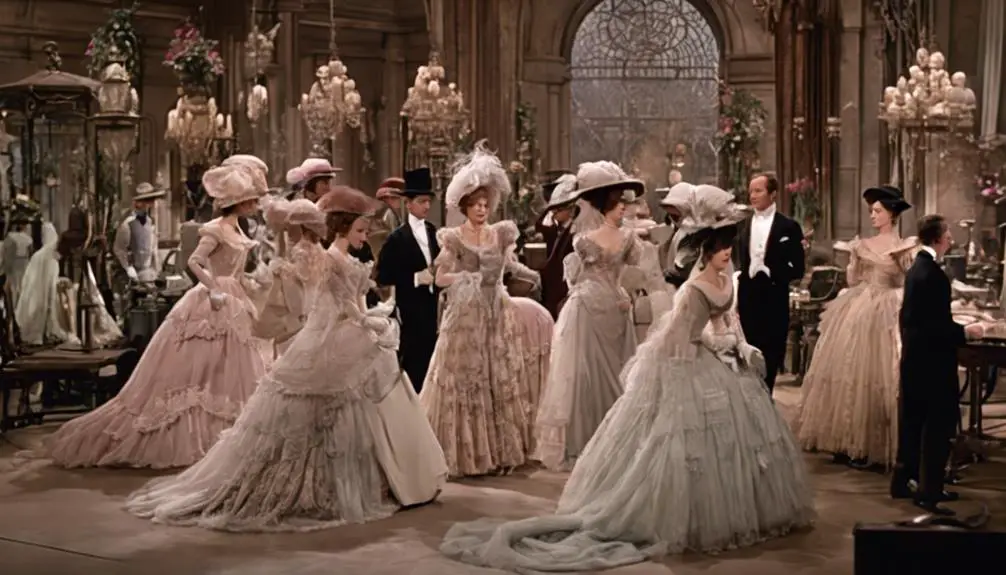
Behind the glamorous visuals of "My Fair Lady," a dedicated team worked tirelessly to bring Cecil Beaton's stunning designs to life. Filming took place over four months, from August to December 1963, with Beaton at the helm of costume design, despite Jack Warner's preference for different actors. This partnership proved fruitful, especially with Julie Andrews, who brought her own flair to the role. Their collaboration faced challenges, including a hat mishap on opening night, but it ultimately blossomed into a creative triumph.
Cecil Beaton's commitment to detail shines through in every garment, including the breathtaking lace dress worn during the iconic Ascot scene. He meticulously sourced 10,000 pearl buttons from his personal curtains, showcasing the dedication that went into crafting each costume. To guarantee historical accuracy, Beaton consulted with society figures on Edwardian fashion, integrating their insights into his designs, which added authenticity to the film's visual splendor.
Behind-the-scenes, the wardrobe department played a vital role, adapting costumes to meet performance requirements while still maintaining period accuracy and character portrayal. Their expertise ensured that each outfit not only looked stunning on screen but also allowed actors like Julie Andrews to perform seamlessly. The synergy between Beaton's artistic vision and the practicalities of costume design created a lasting legacy that continues to inspire fashion enthusiasts today. It's this behind-the-scenes magic that truly brings "My Fair Lady" to life, making it a timeless classic in cinematic history.
Frequently Asked Questions
Who Designed Audrey Hepburn's Clothes in My Fair Lady?
Cecil Beaton designed Audrey Hepburn's costumes, showcasing costume symbolism and fashion evolution. His work captured her character transformation, creating iconic moments. Beaton's designer influence left a lasting cultural impact on fashion and film storytelling.
What Accent Does Audrey Hepburn Have in My Fair Lady?
In *My Fair Lady*, you witness Eliza's accent analysis and linguistic evolution through phonetic training and dialect coaching. Her character transformation highlights the cultural impact of speech, showcasing how accents define social class and identity.
Did Audrey Hepburn Lip Sync in My Fair Lady?
You may wonder about the lip sync controversy surrounding Audrey Hepburn in the film. Due to her singing voice, casting choices led to iconic moments where Marni Nixon's vocal training brought life to the film's production.
Who Designed the White Dress in My Fair Lady?
Cecil Beaton designed the iconic white dress in My Fair Lady, symbolizing elegance. Its fashion influence impacted costume design evolution, blending historical accuracy with artistry, marking a significant moment in iconic film fashion that endures today.

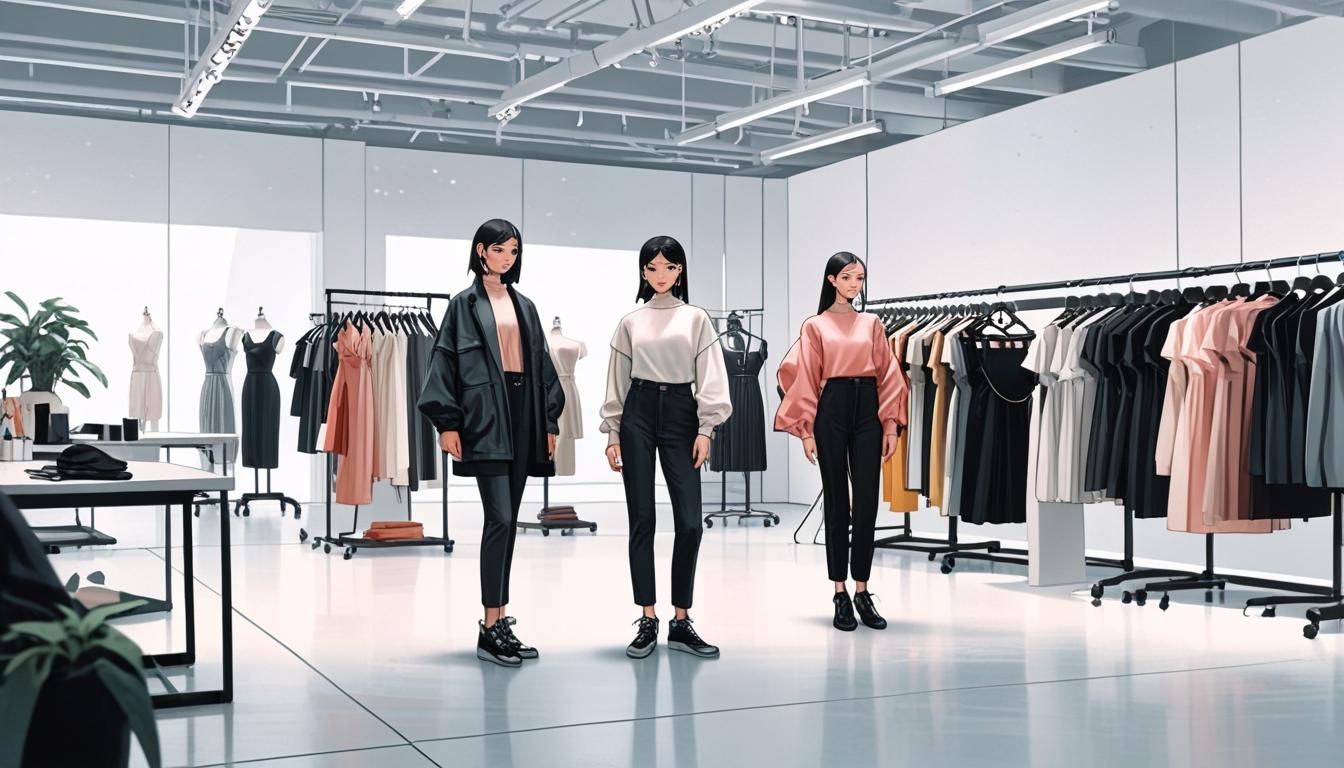
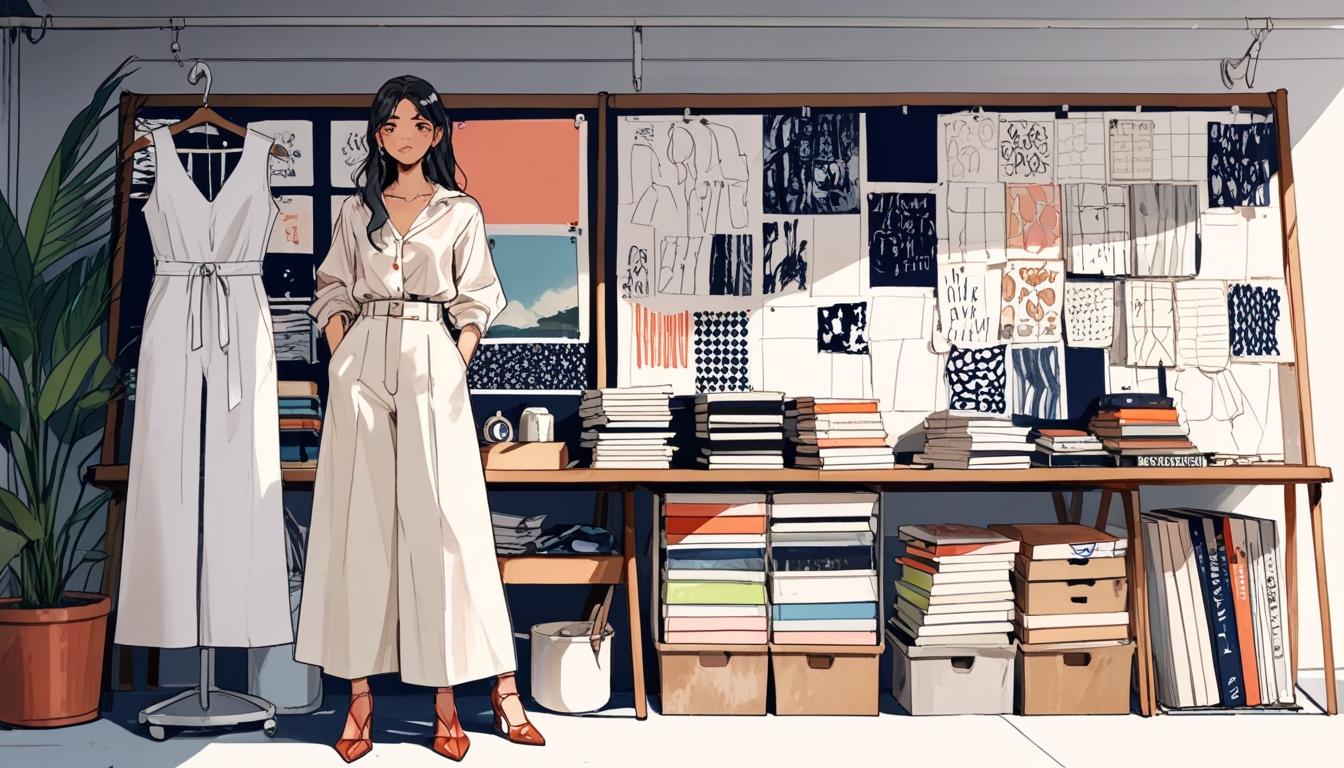

I think this is one of the most significant info for
me. And i’m glad reading your article. But
should remark on few general things, The web site style is wonderful, the articles is really great : D.
Good job, cheers
I appreciate how you’ve structured this information in a logical, easy-to-follow manner.